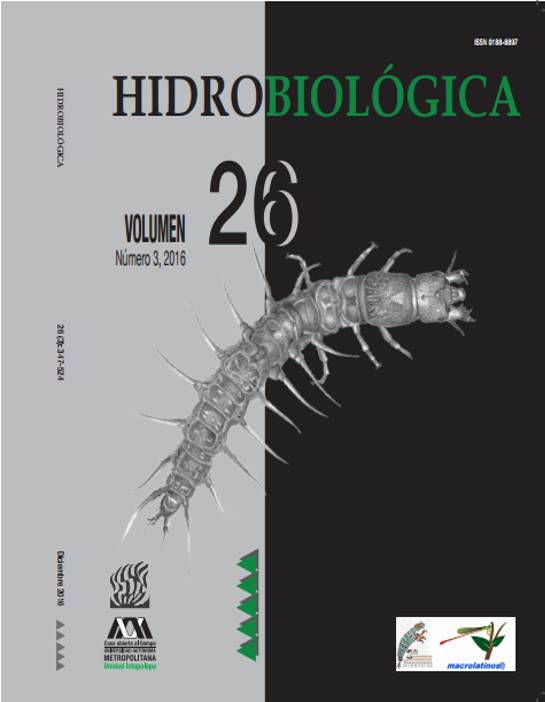Leaf decomposition and colonization by aquatic macroinvertebrates in two tropical microcatchments (Manizales, Colombia)
DOI:
https://doi.org/10.24275/uam/izt/dcbs/hidro/2016v26n3/GuevaraKeywords:
Functional feeding group, invertebrates, leaf litter decomposition, riparian vegetation, tropical ecosystemsAbstract
Nutrient fluxes in low-order streams of both tropical and temperate regions depend on leaves and tree branches originated from their riparian forests. This substratum suffers physical, chemical and biological breakdown, and can be colonized by several benthic macroinvertebrates. However, the effect of different levels of disturbance and degradation operating on these forested streams such as livestock in cattle-dominated landscapes, remains poorly understood, this is particularly noticeable in many mountain areas of Colombia. Goals. To evaluate the breakdown rates and colonization dynamics of benthic macroinvertebrates on leaves of Eucalyptus sp. and Tibouchina lepidota in tropical streams immersed into livestock matrices. Methods. During March to May 2014, we conducted a field experiment using single and mixed (1:1) leaf treatments of both plant species into fine- and coarse-mesh litterbags, in two contrasting streams (reference [La Elvira]/ disturbed [Chuscales]) of the Chinchiná River in central Colombia (Manizales, Caldas). Results. Leaf mass losses were significantly higher in Eucalyptus sp., followed by the mixed (1:1) and T. lepidota treatment into coarse vs. fine mesh bags. However, the higher decomposition rates (k days-1, mean ± SE) were registered at La Elvira for Eucalyptus sp. (fine mesh, k = - 0.0145 ± 0.0026; coarse mesh, k = - 0.0143 ± 0.0019) and, Chuscales for the mixed treatment (fine, k = - 0.0181 ± 0.0053; coarse, k = - 0.0153 ± 0.0046), comparatively. Contrary, macroinvertebrate abundance and density were generally higher in reference than in disturbed stream, and concomitantly to the diversity. However, these variables changed over the sampled period, with higher abundance values registered at 30 days (1129 individuals) and 45 days (958 individuals) in the reference and disturbed stream, respectively. Chironomids and the collectors functional feeding group were the most abundant during all sampling. Conclusions. The results showed that breakdown rate differences between streams cannot be attributed specifically to changes in macroinvertebrate community composition, structure or density and that mesh size more than the livestock effect can influence macroinvertebrate communities colonizing in-stream organic matter; however, further studies are necessary to confirm these results.Downloads
Downloads
Published
How to Cite
Issue
Section
License
Los autores/as que publiquen en esta revista aceptan las siguientes condiciones:
De acuerdo con la legislación de derechos de autor, HIDROBIOLÓGICA reconoce y respeta el derecho moral de los autores, así como la titularidad del derecho patrimonial, el cual será cedido a la revista para su difusión en acceso abierto.
Publicar en la revista HIDROBIOLÓGICA tiene un costo de recuperación de $500 pesos mexicanos por página en blanco y negro (aproximadamente 29 dólares americanos) y $1000 pesos por página a color (aproximadamente 58 dólares americanos).
Todos los textos publicados por HIDROBIOLÓGICA sin excepción se distribuyen amparados bajo la licencia Creative Commons 4.0Atribución-No Comercial (CC BY-NC 4.0 Internacional), que permite a terceros utilizar lo publicado siempre que mencionen la autoría del trabajo y a la primera publicación en esta revista.
Los autores/as pueden realizar otros acuerdos contractuales independientes y adicionales para la distribución no exclusiva de la versión del artículo publicado en HIDROBIOLÓGICA (por ejemplo incluirlo en un repositorio institucional o publicarlo en un libro) siempre que indiquen claramente que el trabajo se publicó por primera vez en HIDROBIOLÓGICA.
Para todo lo anterior, el o los autor(es) deben remitir el formato de Carta-Cesión de la Propiedad de los Derechos de la primera publicación debidamente requisitado y firmado por el autor(es). Este formato se puede enviar por correo electrónico en archivo pdf al correo: enlacerebvistahidrobiológica@gmail.com; rehb@xanum.uam.mx (Carta-Cesión de Propiedad de Derechos de Autor).
Esta obra está bajo una licencia de Creative Commons Reconocimiento-No Comercial 4.0 Internacional.


